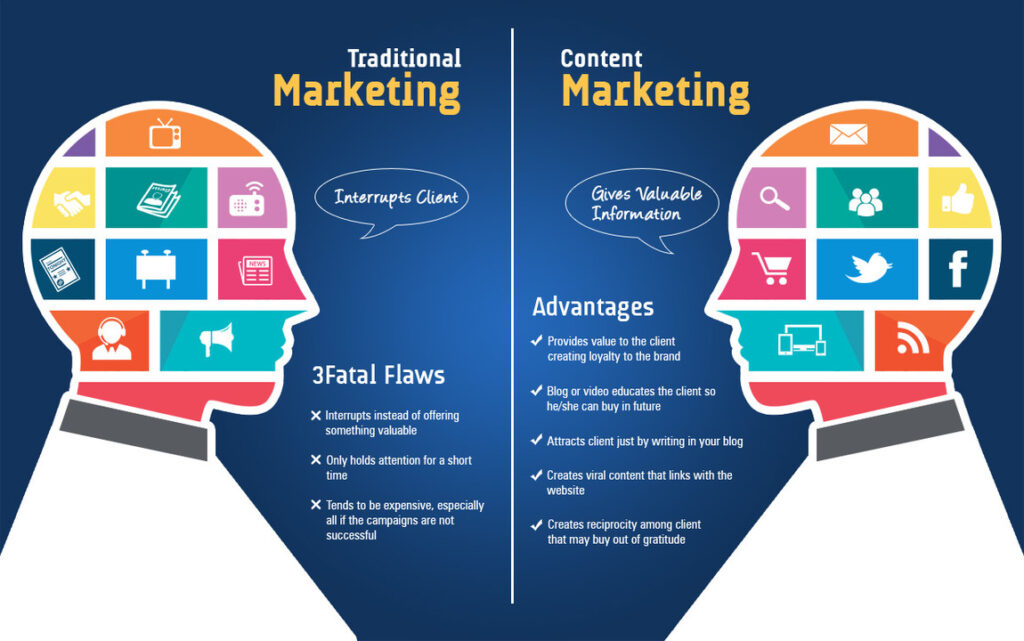Introduction: Traditional marketing and Digital marketing are two distinct approaches to promoting products, services, or brands. While traditional marketing relies on conventional offline channels such as print, television, radio, and direct mail, digital marketing leverages online platforms like websites, social media, email, and search engines. In this comprehensive comparison, we’ll explore the key differences between traditional marketing and digital marketing, their respective strengths and weaknesses, and how businesses can integrate both approaches to maximize their marketing efforts.

I. Definition and Overview: A. Traditional Marketing: 1. Definition and Characteristics 2. Examples: Print ads, TV commercials, Radio spots, Direct mail B. Digital Marketing: 1. Definition and Characteristics 2. Examples: Websites, Social media marketing, Email marketing, Search engine optimization (SEO), Pay-per-click (PPC) advertising
II. Reach and Audience Targeting: A. Traditional Marketing: 1. Broad Reach: Traditional marketing channels can reach a wide audience, including those who may not be active online. 2. Limited Targeting: Targeting options are often limited, leading to less precise audience segmentation. B. Digital Marketing: 1. Global Reach: Digital marketing enables businesses to reach a global audience through online channels. 2. Precise Targeting: Digital marketing offers advanced targeting capabilities, allowing businesses to target specific demographics, interests, behaviors, and geographic locations.
III. Cost and ROI: A. Traditional Marketing: 1. High Costs: Traditional marketing tactics such as TV ads and print ads can be expensive to produce and distribute. 2. Difficult ROI Measurement: It can be challenging to accurately measure the return on investment (ROI) of traditional marketing campaigns. B. Digital Marketing: 1. Cost-Effectiveness: Digital marketing channels often have lower entry costs compared to traditional channels, making it more accessible for small businesses. 2. Measurable ROI: Digital marketing offers robust analytics tools that allow businesses to track and measure the performance of their campaigns in real-time, enabling better ROI measurement and optimization.
IV. Engagement and Interactivity: A. Traditional Marketing: 1. Passive Engagement: Traditional marketing channels typically offer one-way communication, where the audience receives the message passively. 2. Limited Interactivity: There is limited scope for audience interaction or engagement with traditional marketing materials. B. Digital Marketing: 1. Active Engagement: Digital marketing fosters two-way communication, allowing businesses to engage with their audience in real-time. 2. Enhanced Interactivity: Digital marketing platforms offer interactive features such as polls, quizzes, surveys, comments, and sharing options, encouraging active participation from the audience.
V. Flexibility and Adaptability: A. Traditional Marketing: 1. Rigidity: Traditional marketing campaigns often require extensive planning and lead time, making them less flexible and adaptable to changes. 2. Limited Adjustments: Once deployed, traditional marketing materials are challenging to modify or update. B. Digital Marketing: 1. Agility: Digital marketing campaigns can be launched quickly and adjusted in real-time based on performance data and market feedback. 2. Iterative Optimization: Digital marketing allows for continuous optimization and refinement of campaigns to improve effectiveness and achieve better results.
VI. Brand Visibility and Authority: A. Traditional Marketing: 1. Brand Recognition: Traditional marketing channels can contribute to building brand awareness and recognition through repeated exposure. 2. Perceived Authority: Traditional marketing tactics like TV commercials and print ads can lend credibility and authority to a brand. B. Digital Marketing: 1. Online Presence: Digital marketing enhances brand visibility and presence in the online space, where consumers spend a significant amount of time. 2. Thought Leadership: Through content marketing and thought leadership initiatives, digital marketing can position businesses as industry experts and thought leaders in their respective fields.
VII. Integration and Synergy: A. Traditional Marketing: 1. Standalone Campaigns: Traditional marketing campaigns often operate independently of each other, with minimal integration with other marketing channels. 2. Limited Data Sharing: There is limited data sharing and integration between traditional marketing channels, making it challenging to track cross-channel performance. B. Digital Marketing: 1. Integrated Approach: Digital marketing enables businesses to integrate multiple channels and tactics into cohesive, omnichannel campaigns. 2. Data-driven Insights: Digital marketing platforms provide valuable data and insights that can inform decision-making and drive cross-channel optimization and synergy.
VIII. Challenges and Considerations: A. Traditional Marketing: 1. Adapting to Digital Shift: Traditional marketers may face challenges in adapting to the digital landscape and leveraging new technologies and platforms effectively. 2. Declining Effectiveness: With the rise of digital media consumption, traditional marketing channels may experience declining effectiveness and reach. B. Digital Marketing: 1. Information Overload: Digital marketing can lead to information overload, making it challenging for businesses to cut through the clutter and capture audience attention. 2. Evolving Landscape: The digital marketing landscape is constantly evolving, requiring businesses to stay updated with the latest trends, algorithms, and best practices.
IX. Case Studies and Examples: A. Traditional Marketing Case Study: Coca-Cola’s “Share a Coke” Campaign B. Digital Marketing Case Study: Airbnb’s “Live There” Campaign
X. Conclusion: Traditional marketing and digital marketing each have their unique strengths and weaknesses. While traditional marketing offers broad reach and brand authority, digital marketing provides precise targeting, measurable ROI, and enhanced engagement. To maximize marketing effectiveness, businesses should adopt an integrated approach that leverages the